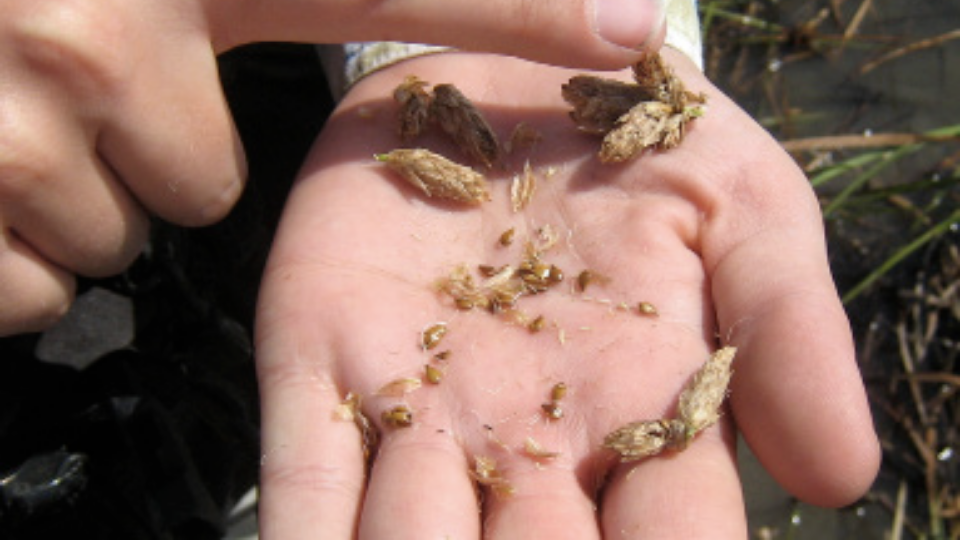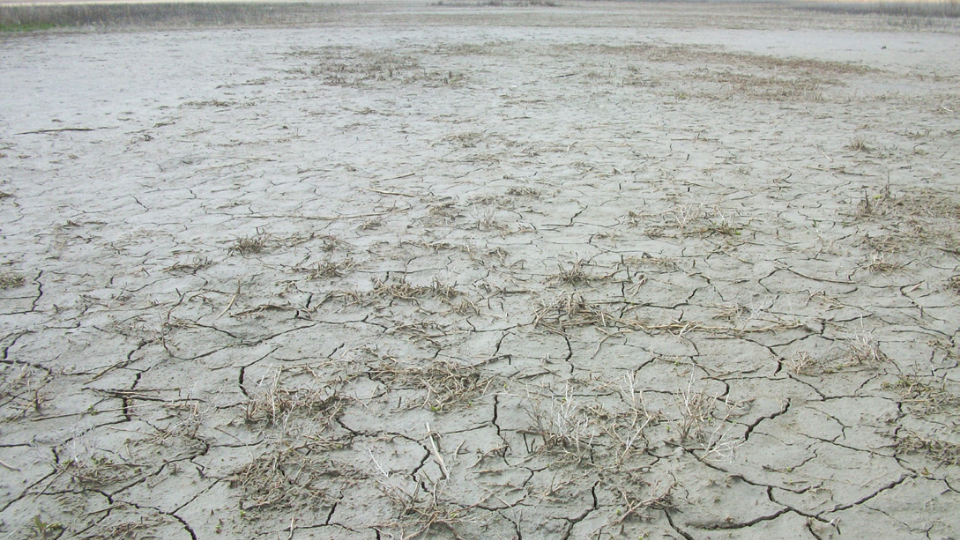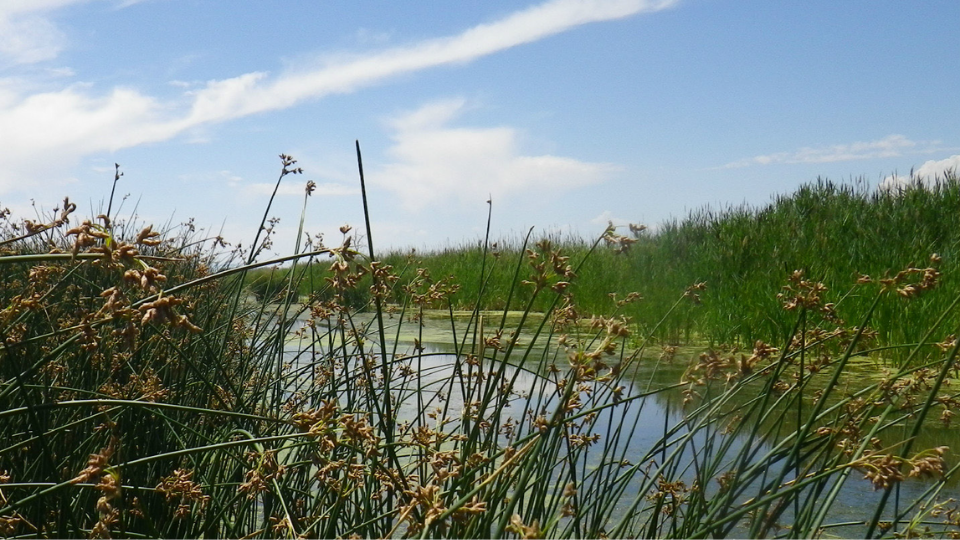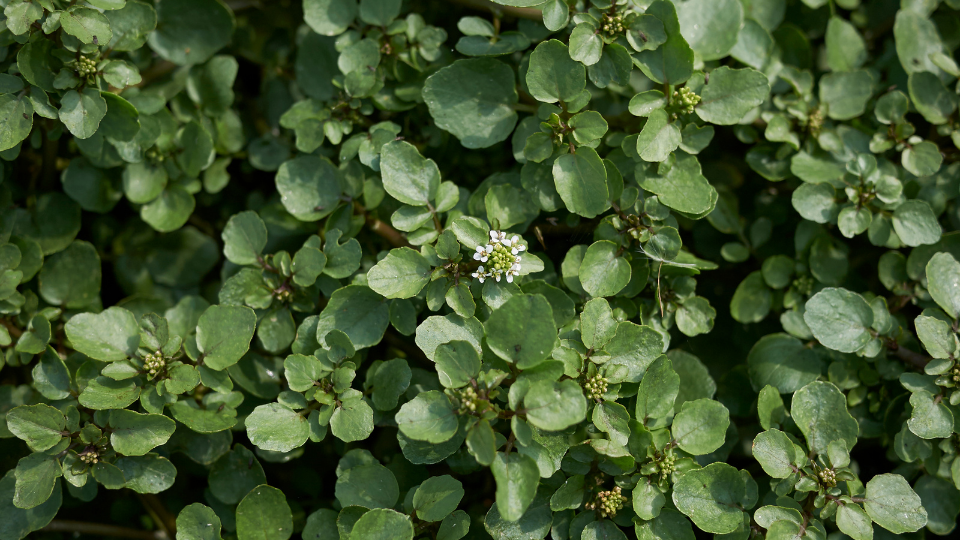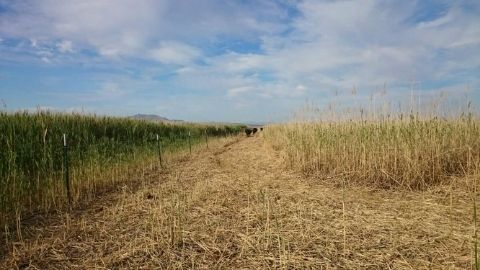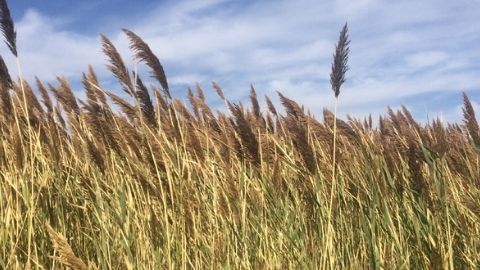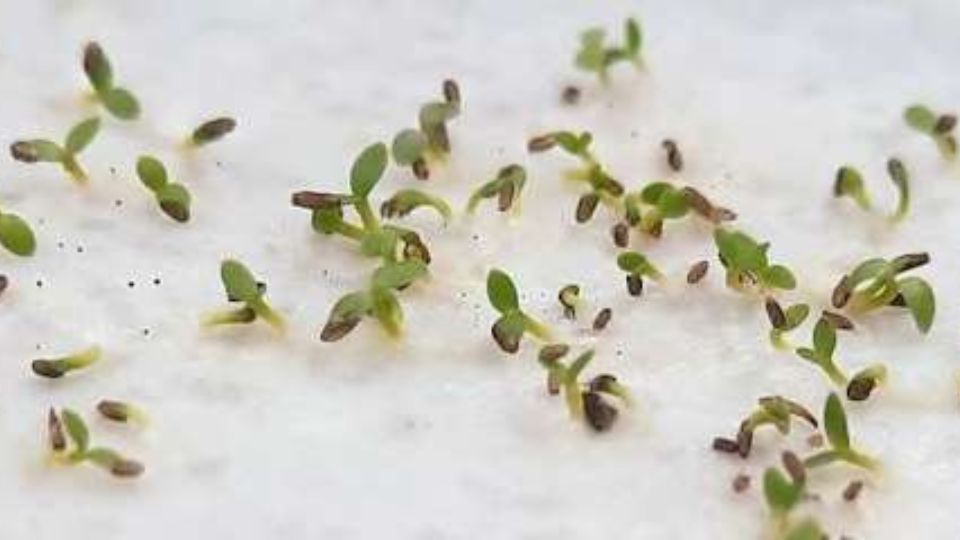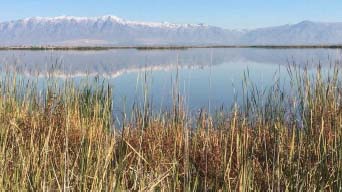Phragmites Control at the Urban/Rural Interface
Developed through the assistance of the Utah Dept. of Agriculture and Food (UDAF); Cap Ferry Agricultural Research Grant Program
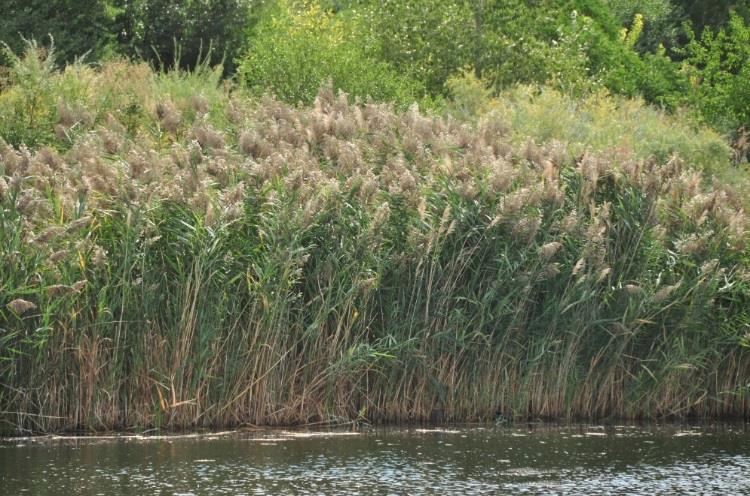
ponds at Kaysville, Utah.
Summary
The non-native version of common reed (Phragmites australis) was introduced to North America from Eurasia in the late 1700s to early 1800s. It is an aggressive, tall, dense wetland grass that crowds out native vegetation. In Utah it has colonized vast acreages around the Great Salt Lake and other wetlands resulting in a loss of habitat for wildlife and access by people. It is also found in smaller wetland areas at the urban/rural interface. Controlling small, urban populations is important to reducing the spread of this weed.
Introduction
Over 200 years ago, a non-native variant of common reed (Phragmites australis) was introduced into the United States. Phragmites, as it is commonly called, is adapted to wetland areas and thrives where soils are moist or covered with shallow water at least part of the year. Since its introduction, this plant has spread into many large wetlands in Utah (Kettenring et al., 2012). In addition, phragmites also infests smaller wetlands and moist, disturbed areas, including those found in urban areas. Drainage ponds, borrow pits, riparian corridors, and irrigation ditches are all susceptible to invasion.
Once established, phragmites roots can reach depths of 10 feet and access ground water even if the surface has dried. It is very aggressive and can spread by seeds or by rhizomes and stolons (belowand aboveground stems, respectively). It creates dense stands with as many as 60 stems per square foot and can grow to a height of 15 feet (Fig. 1). Not only does it grow tall, but the rhizomes and stolons can spread 15-20 feet per year and the shoots can grow 1 ½ inches per day.
Phragmites can be identified by its tall, erect stems with leaves but no branches. The stems are hollow and can be used to distinguish it from common cattails or bulrushes (Fig. 2). In late summer and into the fall it is easily identified by the plumed flower or seed head which is from 6-20 inches long (Fig. 3). The leaves range in size from 4-20 inches long (Fig. 4). Each stem can produce 2,000 seeds, so small urban patches can become a significant source of seed for adjacent, larger wetland areas. While small in size, urban infestations can be hard to control because of the difficulty in using equipment and sprays in wetland sites surrounded by desirable landscape plantings. Watching for phragmites in wetland areas and being able to identify it in a young stage (Fig. 5) can pay big dividends in controlling it without having to spend a lot of time and money later.
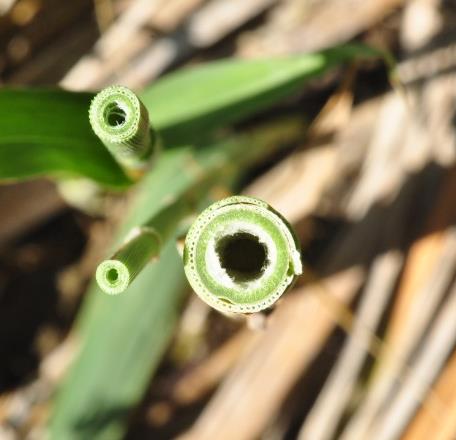


Figure 2. Cross sectional views of phragmites, cattail, and hardstem bulrush stems (left to right).
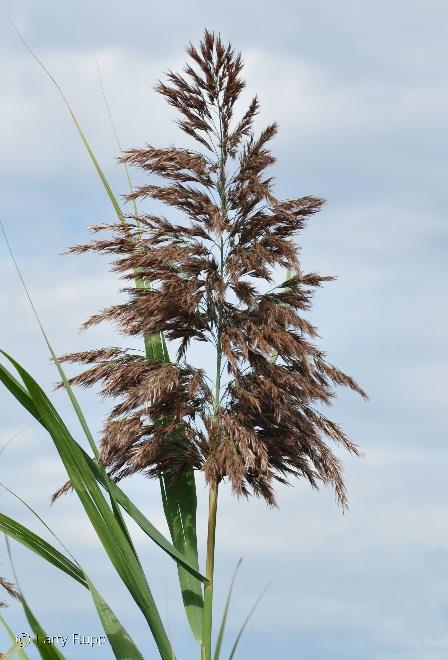
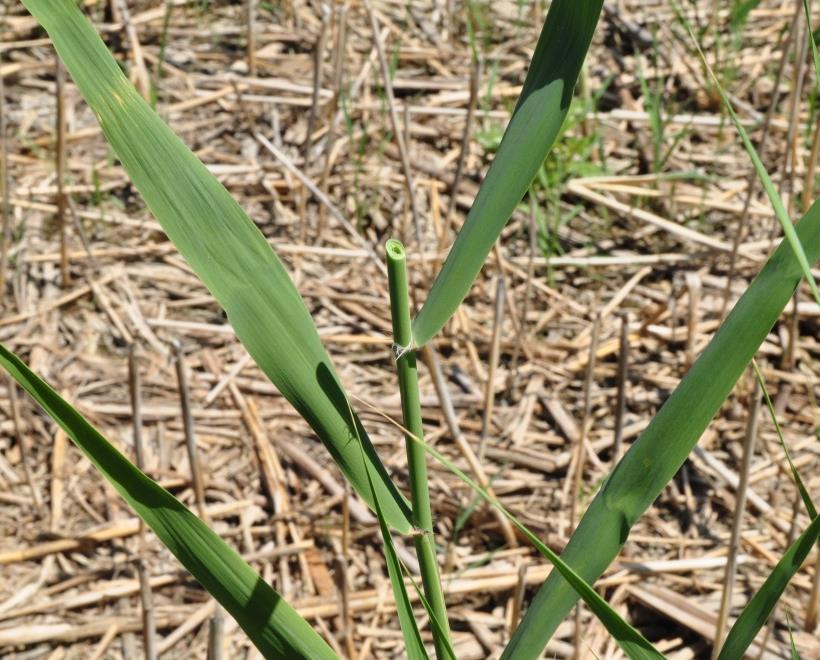
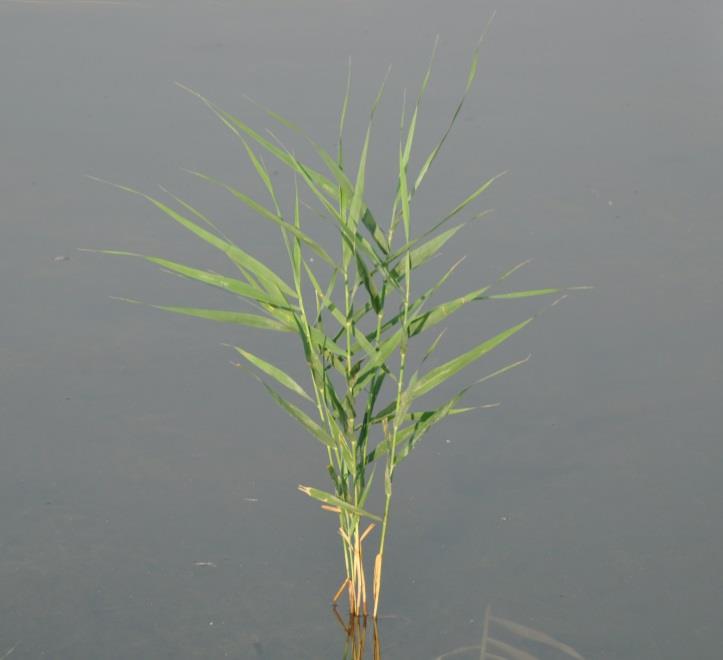
There is also a native phragmites in Utah that is not aggressive. Since it provides many benefits, such as habitat and water purification, it should not be removed. But, it can be difficult to distinguish between the two (Swearingen et al., 2012). The two types do hybridize, although the hybrids seem to be rare and little is known of their ecology. Hybrids can resemble either the native or introduced plants. In general, if phragmites is not aggressive it is probably the native. In particular, landowners south of Utah Valley should take extra care before treating phragmites, since the majority of populations in the southern half of the state are native and not invasive
Phragmites Control
Phragmites is a very difficult weed to control and extensive research exploring ways to manage it continues. Control methods must be tailored to the location and the size of the infestation. For example, in large wetland areas with extensive populations of phragmites, the most effective control to date (2014) is to spray foliar applied herbicides (usually glyphosate) with either aircraft or large tracked marsh vehicles and then either mow, burn, or perhaps graze the residue after the plant dies. However, the control methods used for wildland areas are not adapted to urban landscapes. In addition, much of the equipment used in landscape management is not adapted to use in wetlands, which means mowing or cutting must be done by hand. Here we suggest control methods appropriate for urban landscapes.
Biological Control Methods
There are currently no successful biological control methods for suppressing phragmites. Both insect and microbial biological controls are in development, but it will be several years (as of 2014) before they are available to the public.
Cultural Control Methods
Cultural control involves changing cultural practices or the environment to benefit desirable plants rather than phragmites. For example, phragmites thrives in disturbed wetland soils. If this environment can be changed by flooding or draining, it can reduce the competitiveness of the phragmites. If the water depth is greater than 12 inches the lateral spread of phragmites by rhizomes and stolons is inhibited and seedlings are killed. Draining water so that soils are totally dry also inhibits phragmites seed germination. It is important to remember that if soils are moist, they provide an ideal condition for phragmites seed germination.
Water features in managed landscapes are often lined with rigid or flexible plastic barriers to prevent loss of water. Such barriers should prevent the establishment of phragmites as long as water is not allowed to leak into the adjacent soil and if no soil or rooting substrate is allowed inside the barrier. Desirable water-feature plants can still be utilized by growing in sunken pots within the water feature.
If the water feature does not use a plastic barrier, using an abrupt interface between the soil and water may reduce the potential for phragmites infestation. For example, if ponds or streams are lined with stone, water depths are maintained at 12 or more inches, and the surrounding soil retained by the stone is at a sufficient height above the water table to prevent constant wetting, then the habitat will be less favorable to phragmites. When dealing with natural water features and wetlands, it is important to work within existing laws designed for their protection.
Reduction of fertilizer and nutrient runoff from reaching wetland areas can also help to reduce the competitiveness of phragmites. Planting shrubs or other taller-stature plants around wetland areas can also help minimize phragmites spread by reducing light available for phragmites seeds and seedlings.
Mechanical Control Treatments
Phragmites growth can be inhibited by methods such as mechanical removal, mowing, or the use of weed barriers such as landscape fabric. Of these methods, mechanical removal is probably the most difficult unless the weeds are very small. Phragmites rhizomes can be several feet below the surface of the soil. Simply tilling or disking the soil will only serve to spread the weed.
Weed fabrics may also work where appropriate, but they can be difficult to apply in areas with water and care must be taken to ensure cut stems do not puncture the fabric. Permanent landscape fabrics used with decorative mulches should prohibit phragmites growth.
Mowing or cutting phragmites in mid-summer to late fall can be an effective means of reducing its growth if done on a weekly basis. In areas with standing water, mowing may not be practical. In those cases, the stems must be cut with hedge trimmers or pruning tools. Cutting stems at least 3-5 inches below the water line will enhance control by drowning the rhizomes. When cutting, long stems or flower heads should be removed and disposed of at a landfill rather than composted on-site to insure that seeds do not spread and new plants do not sprout from stems. Removal of live and dead phragmites stems will also encourage growth of desirable plants.
Herbicide Treatments
Treatment with herbicides is often the preferred way to control phragmites. It is the best way to ensure that underground portions of the plant are killed. However, when using herbicides it is important to remember that label recommendations must be followed for use and safety, and that the herbicides must be labeled for use near or in water. Currently recommended herbicides for controlling phragmites in urban areas include glyphosate and imazapyr. Formulations of these products labeled for use near water include Rodeo, AquaNeat, and Aquastar (glyphosate) and Habitat (imazapyr). Glyphosate and imazapyr are both non-selective herbicides and will kill any plants they contact. The primary difference is that glyphosate has no soil activity while imazapyr can be taken up from the soil by the roots.
The current preferred method of control with herbicides is to apply from early July through October, but before a killing frost. After 6-8 weeks the plants will die and dead material should be removed to encourage regrowth of desirable plants and permit easier follow-up herbicide treatments for any phragmites that might have escaped spraying.
Herbicides can be applied with a number of different methods (Fig. 6). In those situations where solid stands of phragmites occur and there are no non-target species of concern, spraying is the most efficient way to apply the herbicide. The spray must be directed only at the phragmites leaves. Spray must not be directed toward leaves higher than the applicator or drift and non-target plant damage will occur. If spraying cannot be limited to phragmites leaves, wiping or injection applications are preferable. Of the two methods, hand wiping with an absorbent glove or towel (take all appropriate caution to prevent contact with skin!) is the simplest, but injecting or dripping into cut stems is also effective.
Follow-up Treatments
Wildland managers have found that invasive weeds cannot be controlled with a single treatment, but require 2 to 3 years or more to control (Hazelton et al,. 2014). The same would apply to weeds in an ornamental landscape; any invasive weed control program should be based on a minimum 3 year plan. Following treatments, dead material should be removed from the landscape with special care taken to prevent spreading of seeds. In each subsequent year, treated areas should be monitored and follow-up treatments applied to surviving weeds. Each year the task should take less time as the number of weeds is reduced, but if a year is missed there is the risk of populations rebounding to previous levels.

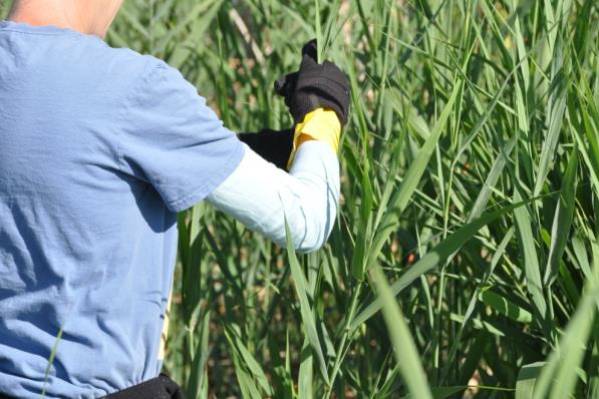
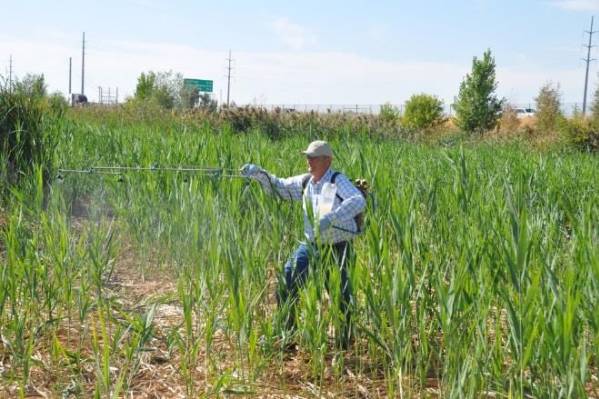
Figure 6. Herbicide application methods including injection into hollow stems with cannula and syringe (A), hand wiping with impregnated cotton glove over plastic glove (B), and traditional backpack sprayer (C).
A study was conducted at the Utah State University Botanical Center in Kaysville to compare three methods of applying glyphosate herbicide (as AquaNeat). The study was done by cutting the phragmites to ground level in early August. This cutting was followed by herbicide treatments in mid-September after the plants had regrown enough to treat. The treatments consisted of spraying with a back-pack sprayer or handwiping (1.5% AquaNeat with 0.25% LI- 700 (surfactant)) or stem injections (50% AquaNeat herbicide and 0.25% LI-700). Hand wiping was done by placing a cotton glove over an impervious plastic glove, saturating the cotton glove in the herbicide, and grasping each stem at the base and drawing it up the stem making sure that all leaves were contacted with the herbicide. Stem injections were done by cutting each stem to 18 inches tall and injecting as much herbicide as would fit into the hollow stem (less than 5 ml) (Fig 2). When evaluated the following year, all treatments reduced the number of phragmites shoots by 65-85% as compared to untreated plants. Further, there was no difference in the amount of control between the three application methods used. Using a spray was the quickest way to apply the herbicide, followed by the wipe, and then the injection. But again, spray treatments have the risk of damaging non-target vegetation.
Recommended Best Management Practices
Small infestations of phragmites in urban landscapes can be effectively controlled by cutting the plants in mid-summer and then applying an herbicide treatment by hand wiping in late summer to early fall. This can be done by preparing a solution of 1.5% glyphosate with a surfactant in an open-mouth container. The herbicide can be applied by spray, wipe, or injection as dictated by local conditions. In properties where there is less risk of collateral plant damage, herbicide sprays may be more efficient and are also very effective. Pump or motorized sprayers can be used to cover smallmedium sized patches efficiently. In landscapes where desirable plants may be damaged by spraying, wiping or injecting may be preferable. Following the death of the plants, the dead shoots should be removed and the process repeated the next year as needed.
In addition, property owners should avoid collecting phragmites seed heads for floral arrangements or other uses, and should not transplant or establish these plants in a landscape setting. Removal of phragmites from urban landscapes and waterways will reduce the potential for infestation of additional land through seeds, rhizomes, or stolons.
References
- Anonymous. A homeowner’s guide to small-scale Phragmites control. North Oakland Headwaters Land Conservancy. http://www.nohlc.org/uploads/6/6/4/1/6641558/ phragmites_doc_final.pdf
- Hazelton, E.L.G., T.J. Mozdzer, D.M. Burdick, K.M. Kettenring, and D.F. Whigham. 2014. “Phragmites australis Management in the United States: a case study, and a review of recent findings and current practice.” AoB Plants doi:10.1093/aobpla/plu001.
- Kettenring, K.M., S. de Blois, and D.P. Hauber. 2012. Moving from a regional to a continental perspective of Phragmites australis invasion in North America. AoB Plants 1-18.
- Knezevic, S.Z., D. Avishek, and R.E. Rapp. Noxious weeds of Nebraska: common reed. University of Nebraska-Lincoln Extension EC166.
- Marks M., B. Lapin, and J. Randall. 1994. Phragmites australis (Phragmites communis): threats, management, and monitoring. Nat Areas J 14:285–294.
- Swearingen, J., K. Saltonstall, and D. Tilley. 2012. Phragmites field guide: distinguishing native and exotic forms of common reed (Phragmites australis) in the United States. http://www.nrcs.usda.gov/Internet/FSE_PLANT MATERIALS/publications/idpmctn11494.pdf
Author Affiliations
- Larry Rupp, USU Extension Horticulturist
- Ralph Whitesides, USU Extension Weed Scientist
- Karin Kettenring, USU Associate Professor of Wetland Ecology, Restoration, and Management
- Eric Hazelton, USU Doctoral Candidate in Ecology
September 2014
Related Research


 Utah 4-H & Youth
Utah 4-H & Youth